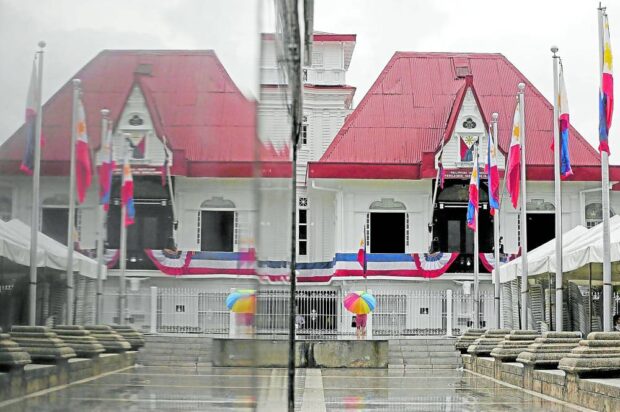
LOOKING BACK | In the rainy weather, a woman visits the Aguinaldo Shrine on the eve of Independence Day, its facade also reflected on the pedestal of President Emilio Aguinaldo’s statue fronting his home. (Photo by RICHARD A. REYES / Philippine Daily Inquirer)
MANILA, Philippines — Every year on or around June 12, there will always be a counterfactual comment that Philippine Independence should rightfully be celebrated on July 4, Philippine-American Friendship Day. Attempting to settle this debate opens us to more than these two dates.
It is not well-known that in 1930 US Sen. Harry Hawes, one of the principal authors of the Hare-Hawes-Cutting Act providing for a timetable for Philippine independence asked Speaker Manuel Roxas for a preferred date. Roxas chose Dec. 30 to commemorate the martyrdom of Jose Rizal.
A pragmatist, he even added that December was one of the coolest months of the year in the islands, cool for independence day celebrations.
To Roxas’ disappointment, however, the US Senate Committee on Insular Affairs, in 1931, changed the date in the Hare-Hawes-Cutting Act and set the date at July 4. After the act was vetoed by US President Herbert Hoover, it was resubmitted with Roxas objecting to July 4.
Colonial ‘friendships’
Senate President Pro Tempore Sergio Osmeña, the other half of the Os-Rox Mission for self-government and independence of the Philippines, then persuaded Roxas to withdraw his objection to the July 4 date on the grounds that the independence of the Philippines was more important than a date for Independence Day. The rest, as they say, is history.
Senate President Manuel Luis Quezon brought home the bacon with the Tydings-McDuffie Law of 1934. At the end of the Second World War the US recognized the independence of the Philippines on July 4, 1946.
Independence Day was celebrated on July 4 from 1946 to 1961 when, with the stroke of Diosdado Macapagal’s pen, Philippine Independence Day was moved to June 12, with July 4 rebranded as Republic Day, and later rebranded again as Filipino-American Friendship Day.
It is quite curious that the Philippines gave a spin on our colonial past by commemorating: Philippine-Spanish Friendship Day on June 30, and Philippines-Japan Friendship month in July.
Other options
Macapagal did not pick June 12 out of a hat, he consulted Filipino historians. Problem is that historians are notorious for bucking consensus making for not one but many possible dates for Philippine independence.
So aside from July 4 and June 12 the other options were: April 12, 1895 when Supremo Andres Bonifacio and the Katipuneros proclaimed independence from Spain by writing “Long Live Philippine Independence!” or words to that effect, on the walls of Pamitinan Cave in Rizal. This date was shot down by those who felt that graffiti on a cave wall did not make for a declaration so they proposed the date in the last days of August when Bonifacio tore his cedula in Balintawak, declared Philippine independence and called for revolution. The official date is now pegged at Aug. 23, 1896 and the site given is Pugadlawin despite arguments from proponents of other dates and other sites.
Esteban de Ocampo, a Cavite historian, provided two dates. First, October 31, 1896 based on a decree signed by then Magdalo member Emilio Aguinaldo calling for revolution against Spain. Second, June 12, 1898 when Ambrosio Rianzares Bautista read the declaration of independence from the window of Aguinaldo’s Kawit home. A proposed date that did not prosper was Oct. 14, 1943 when then President Jose P. Laurel declared the Philippines independent under the Japanese occupation.
Macapagal also chose from Jan. 21, 1899 (the opening of the Malolos Congress) and Jan. 23, 1898 (actually Sept. 29) when the Malolos Congress ratified the June 12 declaration of independence in Kawit.
To nurture and protect
To cut the long story short, Macapagal chose June 12 on the recommendation of Gabriel Fabella of the Philippine Historical Association.
June 12, 1898 is a reference point that calls on all Filipinos to rally to the flag and commemorate the birth of the nation.
Proclaiming or declaring independence is different from attaining independence. Philippine Independence is a precious gift that has to be nurtured and protected 24/7.